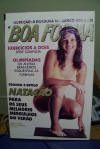Diary/Photo Journal
Week of February 19, 2006
We could not have asked for a better way to start off our week as it was gastronomically introduced with a gigantic and unbelievably delicious Paella. Mauricio (check out the picture from 15 years ago of Mauricio and many of the boyz), was the designated Paella master and he deservedly earned that status. The exquisite food and not to mention the whiskey tasting, led to a very enjoyable evening.
The next day or so was spent getting ready to fly to the State of Goias (Goy-yas) and specifically, to the city of Goiania (Goy-ee-ann-ee-ah) to visit yet another long-time friend, Kike (Key-kay) and his family. Kike (short for Enrique) and Isabele (Eez-ay-bell-ee) have three great kids:- Bruna - 11 going on 20, Lucas - seven years of energy, and Rafael - almost four and makes you wish you were a kid again.
We arrived at the airport with a smiling Kike there to escort us to his "compound" just outside Goiania's city limits. A few acres, many palm, avocado, and various fruit trees, three swimming ponds and one swimming pool and we felt like we were staying at an exclusive resort. Ok, I cannot forget the other members of the household as they made us smile every time we ventured out in the back forty, so-to-speak. Of course, Gerson was rolling his eyes at my immediate expedition to go visit the dogs - three adult black lab mixes, one lovable Dalmatian and her six fat-bellied, silky-soft, loving-eyed puppies.
Kike
and Isabele have two fantastic stories that have to be recognized and applauded.
Isebele, a decorated swimmer, represented Brasil in the 1988 Olympics in Seoul, South
Korea, at the age of 15! She swam the 4x4 relay for a swimming team that was just emerging
on the international scene. To add to that accomplishment, at 19 years of
age, she also
participated and won a ![]() in the
1991 Pan American Games and beautifully graced the cover of a popular magazine.
Now that is LEGAL! (COOL!)
in the
1991 Pan American Games and beautifully graced the cover of a popular magazine.
Now that is LEGAL! (COOL!)
Now, it's Kike's turn...
|
Kike had not given much thought
to the time and pleasures he indulged in while in California because he just felt Upon returning home, he visited
himself upon his family and friends and after all the noise of the reunion
One evening, the young man sat down at a small bar,
ordered up a favorite local beer and wrapped his hands Sooo, you think I have the story wrong eh? Well... Kike
indulged in a sip of the preferred tonic in hopes that the chill of the
cold beer had not yet permeated the Kike asked the bartender why he
could not get a cold beer and the bartender just shrugged and explained
that And, at that moment of anguish,
at that moment disappointment, at that moment of despair, at that
moment.... Well, that was 17 years ago and
that adventurous, cold-beer deprived young man now has two ice
manufacturing And with the
conclusion of this story, I leave you with its moral and thought: The End |
We had a terrific time with Kike and Isabele and their family, and that included a visit by Kike's parents, Carlos and Ilza, from Curitiba. Much pizza was created and subsequently destroyed and many "friendly" games of foosball (or toto - toe-tal) were played. Gerson decided to up the ante on the fun when he found an old rope and proceeded to free-climb a large tree and attach the rope to a large branch. Within seconds, the kids (including the Big kid) were wildly swaying on the impromptu swing. Unfortunately, we all grimaced when we saw the kids coming precariously close to colliding with the trunk of the tree and after Lucas brushed his head across the bark, Gerson reluctantly dismantled his creation.
Now, to move from a person that had an idea, risked everything to realize his dream and worked damn hard for many, many years to a "people" the Brazilians call the "landless ones" (sem-terra - without earth). The landless ones are simply and obviously described as people without land. They are nomadic as they squat or invade other people's lands and build makeshift communities.
Unfortunately, there is a Brazilian law that liberally states if sem-terras live on a piece of seemingly unused land for five years, they cannot be removed. The land does not become theirs; however, the rightful owner cannot remove them (or get "caught" removing them). This is a simplified explanation of how the "favelas" or slums in Rio de Janeiro have been formed and why they cannot be eliminated.
Another unfortunate thing is that many of the large churches encourage the landless ones to occupy lands in visible places. They are told to erect a tall, red flag to mark their territory and to make themselves known to the government and to the surrounding peoples. They live in squalid conditions and often plant a small garden around their scrap-wood and plastic huts. They strip the area of its resources and do very little to manage their waste products.
My problem with this is the idea that if a landowner (only a small minority received their lands through questionable means) cannot evict these land poachers, the landowner risks losing his land to deforestation, erosion, pollution, etc. The landless ones have no motivation to take care of the land because it is not really theirs to manage. And, if the landowner is correctly managing the land, there will always be large areas of earth that have to sit fallow for a season or more in order for the natural nutrients to be reintroduced into the soil.
Imagine leaving a plot of land fallow so that it can properly and naturally rebuild its nutrients when a group of sem-terras take it over and strip the land of everything. If there are many, then the landowner is outnumbered and threatened and often cannot remove the invaders. It becomes a vicious cycle and an unfair one for the landowner.
While we were visiting Kike, a friend of his showed up and invited us to spend Carnaval weekend at his Fazenda. As we were planning on making a jaunt to a few cities within a few hundred kilometers of Kike's home, Neto's offer to stay on his farm near Pirenopolis was welcome indeed.
We borrowed Kike's truck and made our way to a beautiful town called Goias Velho (Goy-yes Val-yo) and it lived up to its name of representing old Goias (Velho means "old"). The streets were lined with hand-placed stones and it seemed that at every corner we walked, there was yet another picture-perfect street with quaint homes and buildings. We even strayed onto a street called "Dr Americano do Brasil" which means "an American of Brasil". Of course, we got a picture of you-know-who with that street sign.
After our short pass through Goias Velho, it was off in search of Neto's Fazenda (farm). It is not that 240 acres would be difficult to find except we are talking about 30 kilometers off the main road through the famous "cerrado" (say-hah-do - a combination of forest and jungle plants, but low in stature), and there are no signs. Of course, we had the kilometers to mark where to turn; however, the odometer in the truck was not in working order. So, with a little guesswork and a lot of "I don't know, you decide" being said between us, we found the Fazenda Alvorada (which means "first sunrise") nestled in between breathtaking hills surrounded by mountains.
  |
View from the sheep pen to the main house and from the house to the sheep |
  |
There is a good reason why this hammock is smiling as well as myself - look at that view of Neto's family's land |
Neto was there with a few of his friends - girlfriend Cristina, friend Ricardo and his wife, Priscilla. After the introductions were finalized and our rooms sorted out, it was off to explore and make ready for the bar-b-que.
Needless to say, our first day on the Fazenda was filled with fun, food and laughter as the Cachaca (Kah-shah-sa - Brazilian rum), cerveja and vinho kicked in and the food (which consisted of freshly "departed" lamb, picanha, sausage, etc.) never seemed to stop coming off of the grill.
The Fazenda is a working farm that consists
of four employees, cows, sheep, chickens, horses, mules, dogs and the occasional
jaguar. Yes, I said jaguar...as just the night before we arrived, a
juvenile jaguar killed a stray sheep and performed the trick again the night we
left. As Neto simply put it, that is the cost of having the Fazenda in
such a beautiful place and the jaguar is just a wild animal that is living its
life as it should. Neto stated that there really is not much to be
concerned about as the cats do not attack people or the larger animals.
Could you imagine that sentiment in the United States? Geez, immediately
there would be an enormous uproar about how dare the wild animal encroach on the
land we forced the animal out of and then there would be a hunting party that
would have no intention of allowing the animal to live. Ok, I am venting
my opinion here...but the number of mountain lions killed around Southern
California vs. those that are humanely captured and relocated is noticeably and
remarkably unbalanced toward the number of lions killed.
Ok, off the soapbox....and onto the horses. We took advantage of a gorgeous morning to indulge in a dreamlike ride through the hills and down to a clear river that winds its way through the Fazenda. The Fazenda breeds both horses and mules and wherein I received a mule to ride, I was not at all disappointed by the responsiveness, the sure-footedness and the speed of my mount. She was very much appreciated when we started down a incredibly steep slope lined with shale and loose rock and not a slip under even one hoof.
We spent the majority of the morning walking, trotting and galloping around the Fazenda and included an hour of soaking our sore backsides in the river. Gerson even managed to pick up a few hitchhikers along the way and we later got to celebrate with a tick-burning ceremony.
Finishing off the morning, we just lounged around the Fazenda and enjoyed the ambience of such a beautiful place. We wandered around the sheep pens and saw quite a few rather "bald" sheep and their wool hanging in the rafters. The afternoon and early evening included a planned trip into Pirenopolis for a little Carnaval celebration and for wandering the streets of yet another quaint city.
Pirenopolis comes alive for Carnaval as much of the population of nearby Brasilia, Brasil's capital city, come to this quaint town to feast and fiesta. Again, streets that are a photographer's dream were everywhere with a very solemn reminder: every stone that was laid on the street was done by the hands of slaves. When you see the millions of stones used for these streets, one cannot imagine the work it took to create this lasting thing of beauty.
  |
Views of Pirenopolis and Carnaval and
crowds Each stone laid by a slave's hand hundreds of years ago |
 |
Carnaval in a nutshell...people (mostly young men) walking the streets and drinking... |
We returned to the Fazenda wherein we again enjoyed a bar-b-que and laughed at the antics of "Montanha", the sire of Sheriff (the dog that accompanied us on our ride). We finished our brief respite on the Fazenda with the assurance to Neto that we would definitely return the next time we are in Brasil.
Home Page Brasil-South America Diary Index Previous Diary page BR-SA Diary page 4























































